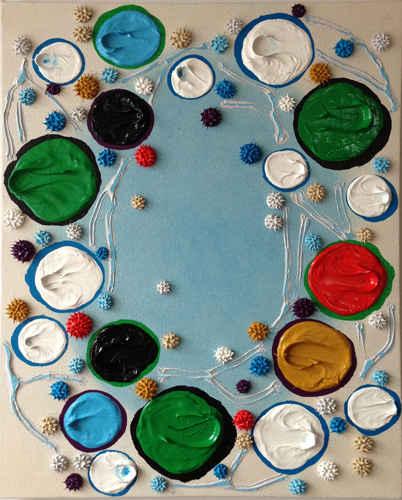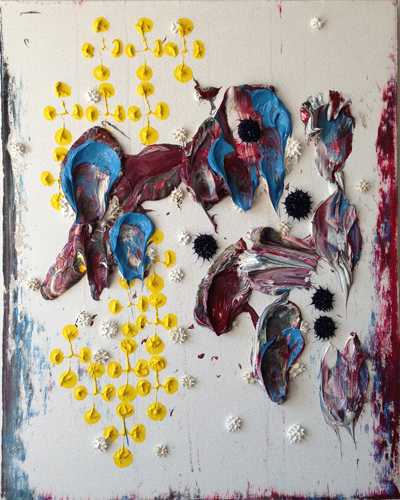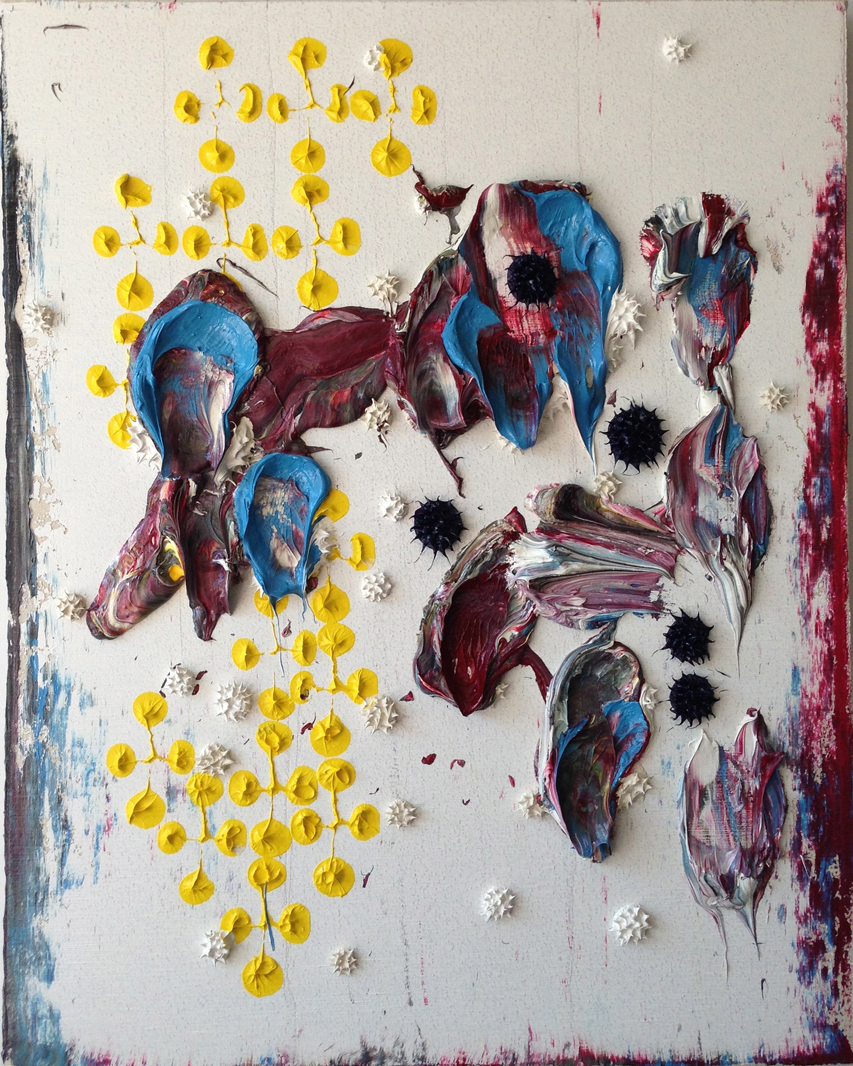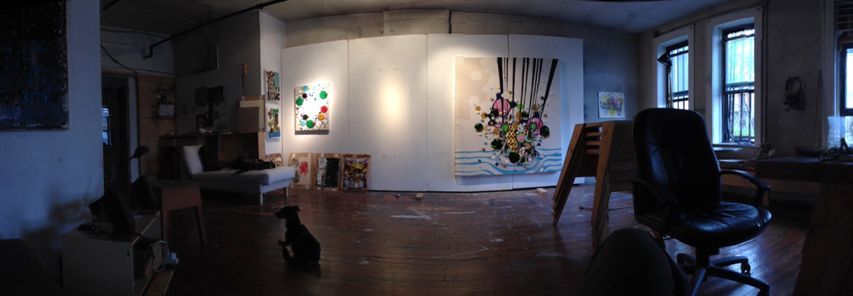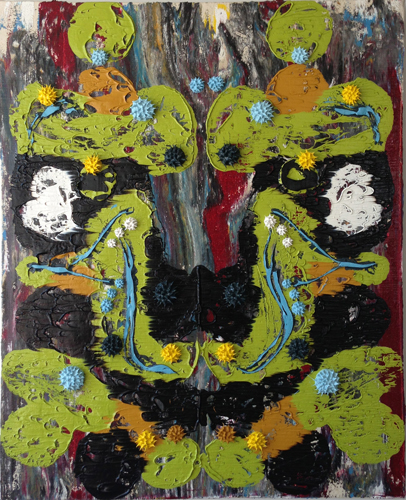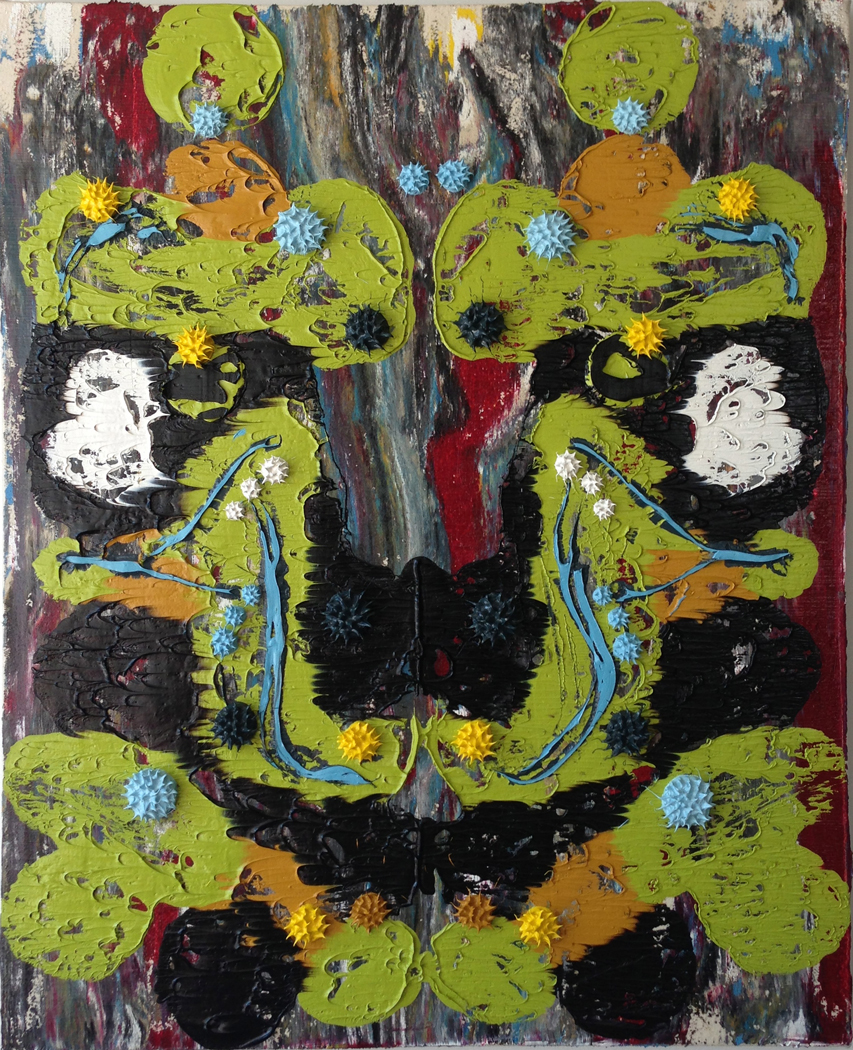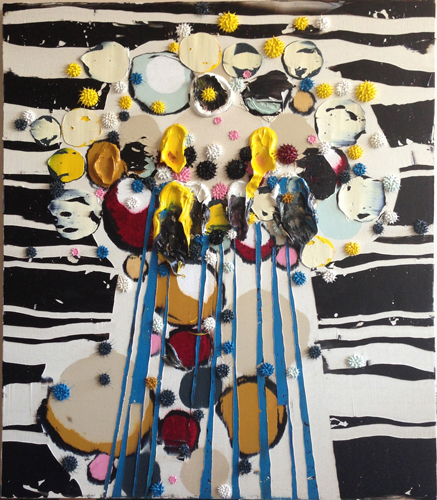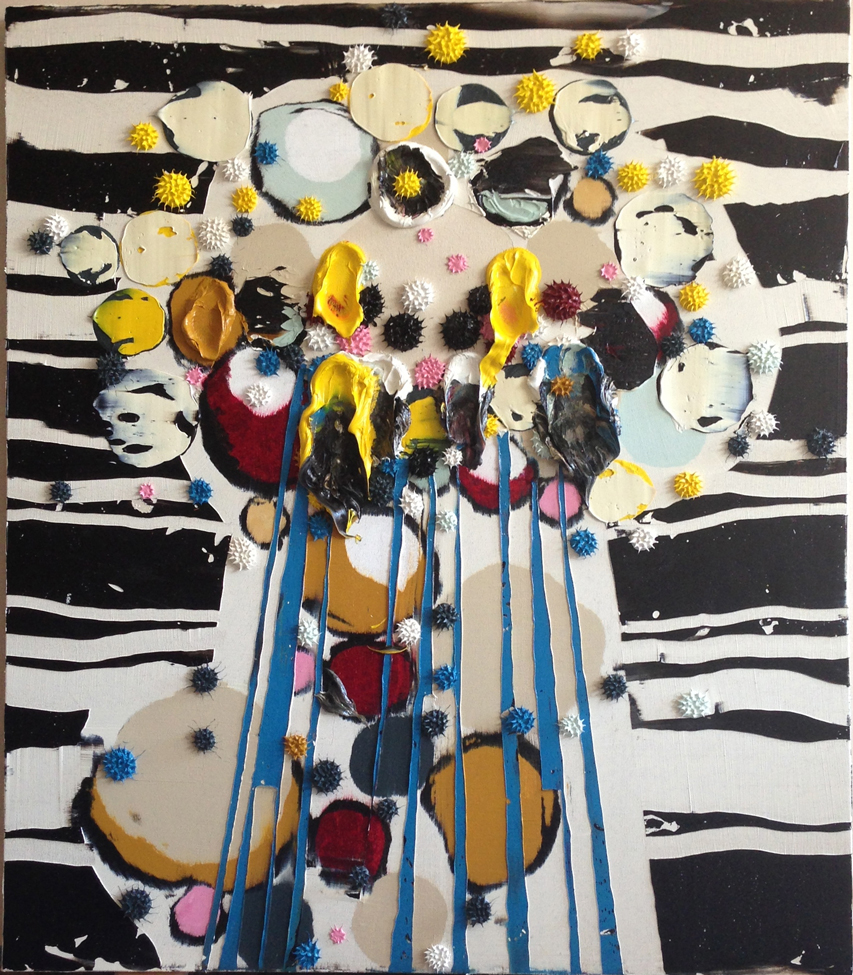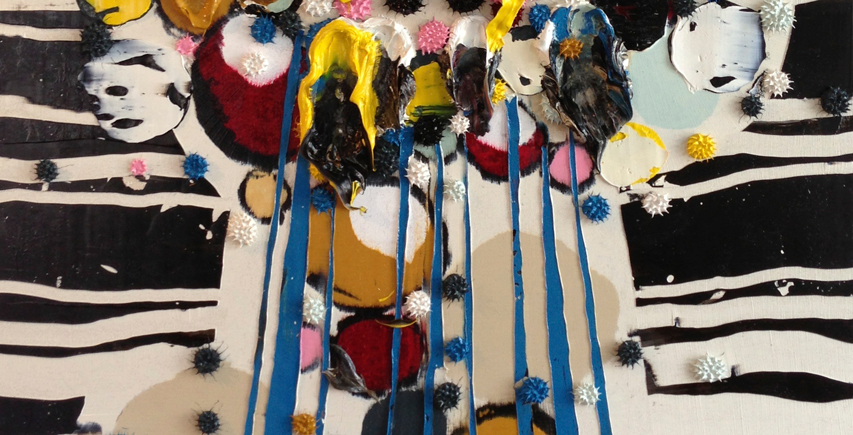June 27, 2013
notes on a conversation with S.C.
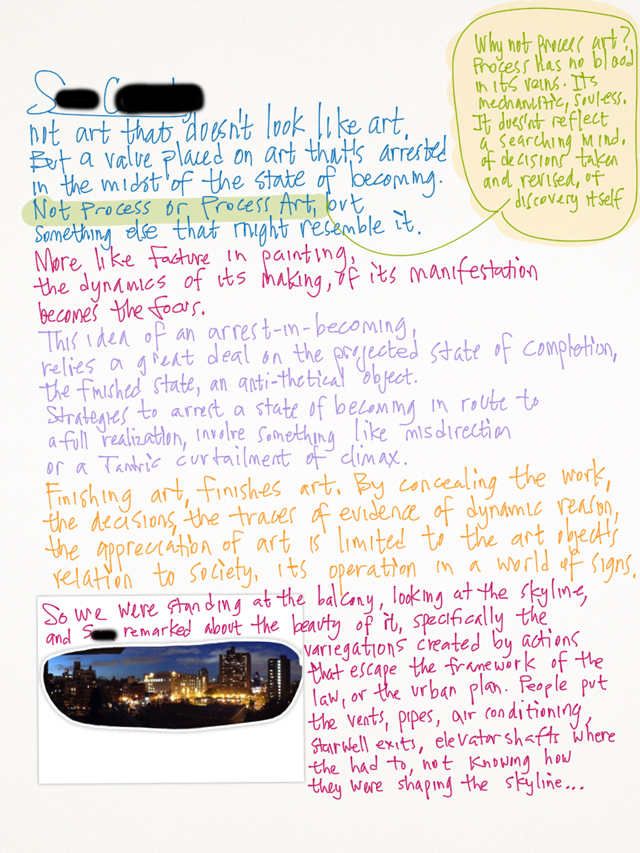
(A friend was in the city for a visit, we had great conversations. Just after he took off, I was thinking about it, too much, so I started to jot notes to externalize the thoughts and examine them. He mentioned his appreciation of art that doesn't look like art. I suggested that this avenue gets eclipsed too fast in our culture, that perhaps the issue in his sculpture was about something like facture in painting, paint handling, plasticity.
I'll continue dumping thoughts after the jump...)
...so the problem is how one can capture art in the wild, before the domestication of the frame. It's a tricky thing to do. Once you apprehend the wild thing, you domesticate it. A measure of wildness is lost. In terms of painting, one can paint with wildness, carelessness, like a crazy person... but for how long? How can one resist the concretion of method?
Alfred Jarry comes to mind with his pataphysics. He was as wild as a bar fly with a gun who was willing to shoot it off as a method of punctuation. One could prolong this adventure with complexity and play, with irreverence and humor. He was like a squid that squirts ink in an escape from the confinement of rationality. Bewilderment was his method (like McCarthy too?). But Jarry also always made poetic sense, his imagination didn't close down as it does in an environment constituted only of noise. There are other methods, too. One could be feral and refuse to marry any medium, where life as an artist is a series of one night stands with art media and method. Jarry was good, great even, and the good die young. Methods of revolt in the realm of the imagination impinge on the realm of life, thus shortening it. Maybe shortening life is a good method too, one could foreclose the foreclosure of technique and everyone will project a subsequent potential that might have been. (But what a terrible thought this is!)
You have to lay in wait. A surprise attack. A random framing action. Didn't Duchamp's Three Standard Stoppages do this? He laid traps. The moment of recognizing the beauty of the unplanned skyline is a kind of stoppage. I pause to consider this. But did Marcel ever find himself suspicious that the randomization technique itself was a product of a (suspicious) rational construct? Didn't he stop to think that the string he dropped to the floor was first selected for it's length, for it's thickness, the height of the drop, it's suppleness as it fell. Randomness is harried by the frame. Isn't there an uncertainty principle in operation here? In the way that one can know either position or momentum, one cannot know both at once; so too randomness and framing are complementary variables?
It's about searching for strangeness, isn't it? Some artists do it a little, some a lot, but can any do it to an ultimate extreme, to the point of estrangement?
And perhaps there are substances like the materials of building construction (my friend's preferred palette), of architecture: steel studs, drywall, concrete- that resist the frame of an art gallery or museum precisely because they are too much like what literally constitutes the frame of an exhibition space. Sure, sculptors like Richard Serra used the steel of ship construction, but his work might be too pure (the weight and totality of his various tilted arcs traces a curve for me that leads somehow to Henry Moore) for my friend in this conversation. After all, Serra was no Jarry.
Once you repeat a certain aspect of facture -often a sign of control- you have tamed its savage nature. So how do you continue to employ the "feral" move without substituting for it, a domesticated facsimile of what it once was? (Some artists don't care about this, they carry on and the audience carries on in tacit agreement that they are all outlaws, but we aren't talking about them, we're talking about the real thing.) True wildness doesn't care about art or anything civilized. Wildness moves according to its own agenda, perhaps something resembling Anton Chigurh, a character in the movie No Country for Old Men a film character that I thought was a good representation of the force of nature itself: impersonal, subjecting humanity to the laws of chance, empty of empathy, of all the compassion of a Mack truck that bounced out his freeway lane over the traffic median as it fills up your windshield.
There are creatures that can never be domesticated, like tigers or sharks; or creatures that almost can be cooperative like bears or water buffalos. But can anything in culture compare to this? War, maybe. A war between actors within the framework of a Geneva convention would be like the latter dancing bear; a terror war or piracy would be like the former. A tiger within the fame of a zoo is majestic, but could we feel such majesty if we looked into the eyes of one in a jungle? In the wild?
Remember the skyline? The profile of the buildings against the sky isn't wild and unplanned, the planning is smaller in scale. The logic of placement of the apparently random elements was made within the logic of each building, of each property owner. These decisions escaped the planner's vision, true, but decision and placement exists. Our perspective shifted to see an aspect we had not considered before. This reminds me of Malevich's revelation of abstraction as it was provoked by the emergence of aerial photography. The view from the air was strange and flying was wild for a time. This frisson of modernity, the thrill of seeing a world without a horizon created abstraction as we know it. Maybe this could be another definition of abstraction: the capture of de-familiarization. It was sudden and thrilling then and we have trying to recreate that feeling ever since.
Why are we attracted to this wild quality? Sex drugs and rock and roll. Danger and copulation always get our attention. It's hardwired in us, the limbic system, the twitch of the amygdala, a brain stem, lizard thing. We all do it in ways great and small. So why do we as artists pander to base things? Perhaps its because its an effective way to reorder our categorical precepts? It's a direct way to wake us up, to be modern in the radical sense of reconciling the life we are living with the things we are making, to strip off all preconceived notions, of inherited conventions. Our cerebral cortex has us living too much in the future or the past, sometimes you've got to break some china to be fully awake in the moment.
Or maybe it's a way for culture to grow by taking bites of the wild and digesting it mouthful by mouthful.
For Papa Smurf
This quotation is featured at the top of the Armory on Park's postcard emailer for Paul McCarthy's White Snow exhibition in the Upper East Side:
"My work seems to be about tearing down and opening up conventions. My responsibility is to the ideas - that's the difference between making art and making entertainment."(Papa Smurf is a favorite appellation for McCarthy among my friends.)
A few thoughts follow...
(Paul McCarthy is one of the most influential artists for artists of our generation, a touchstone and a standard to measure ourselves by. Of course, I'm a recent transplant from Los Angeles to New York City and my views are heavily conditioned by the Southern California art scene. The thoughts I am about to convey might seem heretical to some, but I want to assure those who are broad minded and dedicated to independent thinking that it is because I hold his significance in high regard that he is worthy of analysis and I remain after all, a respectful admirer of McCarthy and his generation.)
The conditional "seems"leads the quotation. It implies misdirection. If the tearing down and opening up of conventions is only seemingly so, then what is actually so? Of course, this could be merely an artifact of speech, that "seems" is a way to soften the literalness of what follows. What is not conditioned is his pledge to be responsible to ideas, where he draws the line between serious art and frivolous entertainment.
Is the agency of ideas the prime definition of art?(*2) Is entertainment bereft of ideas? Aren't realms such as philosophy and news reportage for example also responsible to the traffic of ideas as well? All this and more flow to mind after reading this quotation, which is typical to the literature surrounding Paul McCarthy.
The ways an artist should relate to the public have been stamped on every generation since the 60's by Warhol: be a cypher, don't allow yourself to be circumscribed by logic of your interlocutor, remain aloof and disarmingly cryptic. Of course, I don't follow that program entirely. Personally, I think that there is enough lacuna (space, interval) within any train of thought and logic for the imagination to find an escape. And it is interesting and admirable to me that McCarthy unleashes plenty of rational reflection on his work, which I suppose is an influence from his role as a professor at UCLA since 1982.
The work of Chris Burden comes to mind. Both Burden and McCarthy came out of school at the same time, created performances at the same time, their work speaks for a generation. Personally, I've been able to make sense of Burden's oeuvre as an expression of power. Whether it was about putting himself in danger (laying under a tarp on a roadway, shooting planes, being shot, or crucifixion) or manifesting the US submarine fleet or the solar system or scaled up police uniforms, the theme was always power in several manifestations. Does this also shine a light on McCarthy's work as well? If so, McCarthy's thematic of power seems to be Oedipal patricidal about a critique of patriarchy that was the overlord of his generation. The Hauser & Wirth announcement quotes the NY Times: "...ribald, pop-culture obsessed provocateur...", and H&W underlines this, writing "Adding a touch of malice to subjects that have been traditionally revered for their innocence or purity...".
All this seems to seal the deal, McCarthy is out to kill the father, much as we have in several sectors of auto-critical pop culture, for example movies like American Beauty. We are all very familiar with this trope, it exists in a grand cycle that has turned for around fifty years or so. Now, isn't McCarthy himself quite a patriarch? As he emulates Walt Disney (who might be the source of McCarthy's echo about art-as-idea, if you watch the video to its conclusion), one can see that his acidic critique is integral with admiration. So a big part of the set of ideas in his art isn't solely about bringing down the man, patriarchal critique, it is also a tribute to an object of admiration. Indeed he is quite the family man, by cultivating a thriving and happy brood of children who are well seated to carry on his legacy, he is the very image of happy patriarch known throughout all history and all cultures. He's not only a good father but a good and caring mentor to his crew of artists in his studio (the echoes of Disney reverberate in the video above). What might be actually so in his traffic of ideas is a complicated entanglement of thoughts, and one can only appreciate the complex interweave in a comparison between what is said and what is lived in his life.
McCarthy has done in spades what must be done by all artists of all generations for all time (time, in terms of Western art history), he questioned the set of values that he inherited and redefined them for fitness to his generation. So here is the biggest question for the subsequent generation: how can we question him? How can we rebel against rebellion without becoming reactionary ourselves? Or have we come to the end of art as so many of the previous generation are fond of declaring? Are all we have left is footnotes and bibliography with no new chapters possible to be written?
Cue Jim Morrison, a key part of McCarthy's generation:The killer awoke before dawn, he put his boots on
He took a face from the ancient gallery
And he walked on down the hall
He went into the room where his sister lived, and...then he
Paid a visit to his brother, and then he
He walked on down the hall, and
And he came to a door...and he looked inside
Father, yes son, I want to kill you
Mother...I want to...fuck you
*PS: As long as McCarthy is professing his emulation of Walt Disney, it would be good to look into the figure who inspired Disney himself, Fred Harvey:
Fred Harvey was Ray Kroc before McDonald's, J. W. Marriott before Marriott Hotels, Howard Johnson before Hojo's, Joe Horn and Frank Hardart before Horn & Hardart's, Howard Schultz before Starbucks. And from the moment in 1878 when he lured the top chef at Chicago's vaunted Palmer House to run his first high- end restaurant and hotel -- in a refurbished fleabag in Florence, Kansas, a town so small that the population often doubled when the Santa Fe train pulled into the station -- Fred Harvey's managers and chefs became some of the first hospitality heroes of America. When the son of Kaiser Wilhelm stayed at La Fonda, the legendary Fred Harvey hotel in Santa Fe, he was thrilled to discover in the kitchen Chef Konrad Allgaier, who had cooked for his family in Germany.Emphasis mine, one can't emphasize it enough. It's worth a google search to see how much Disney patterned himself on Harvey.Fred Harvey was also Walt Disney before Disneyland. He and his partners at the Santa Fe played a huge role in the development of American tourism as we know it. Fred Harvey was largely responsible for the creation of the Grand Canyon as the country's premier natural tourist attraction, as well as the development of the mythic Southwest and what grew into the National Park System.
*PS2: By the way, I think art is about the imagination.
June 26, 2013
Adam Janes, da haps
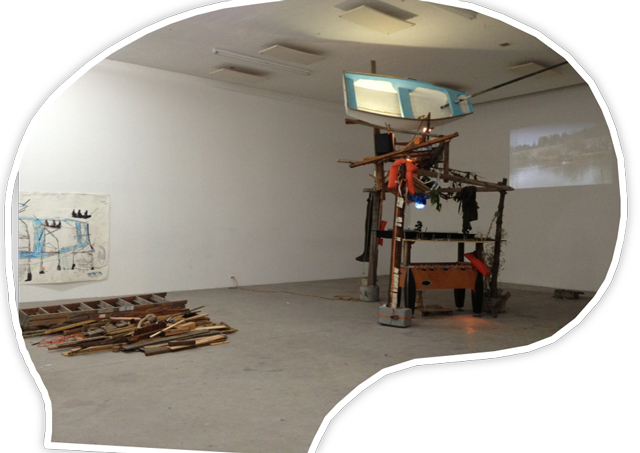
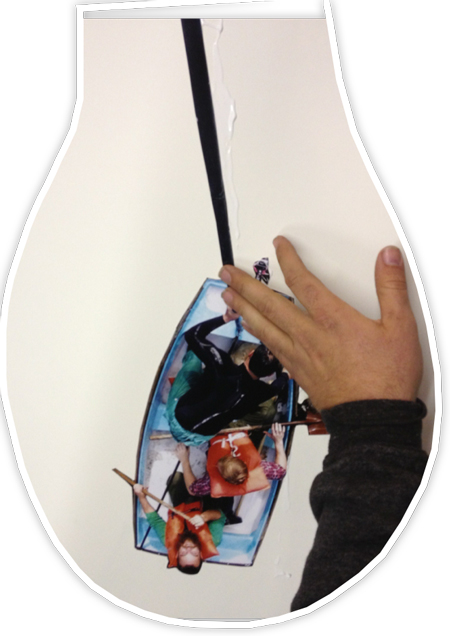
Adam Janes sent me images of his recent shenanigans with his collaborators Justin Miller & Andrew Sexton. I messed around with them as I am wont to do. For a better look at the stuff they're doing, click on and in Adam's site.
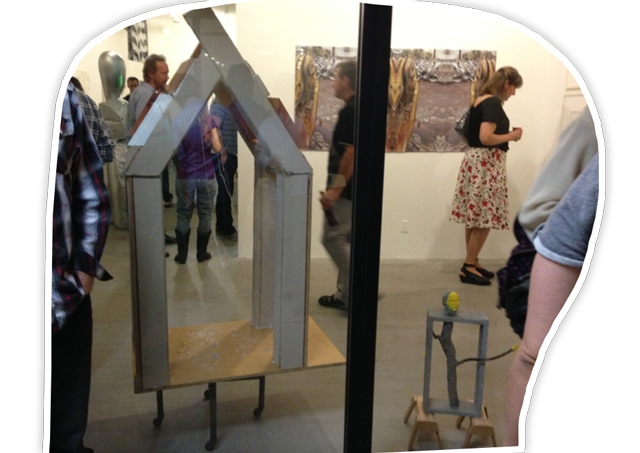
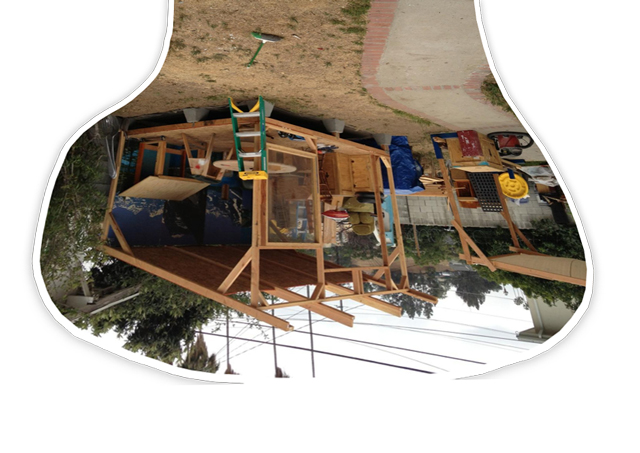
June 25, 2013
June 22, 2013
Vitrine
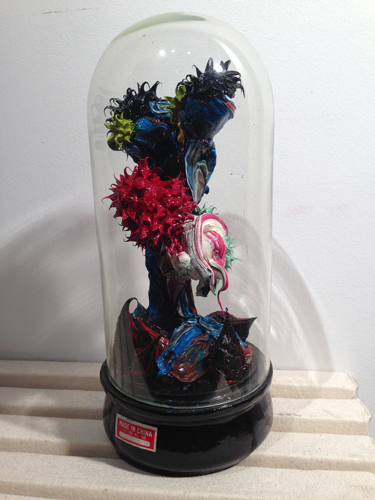
en cada una de ellas
#416
2013
12"x5"diameter
Oil on Wood Armature, Glass Vitrine
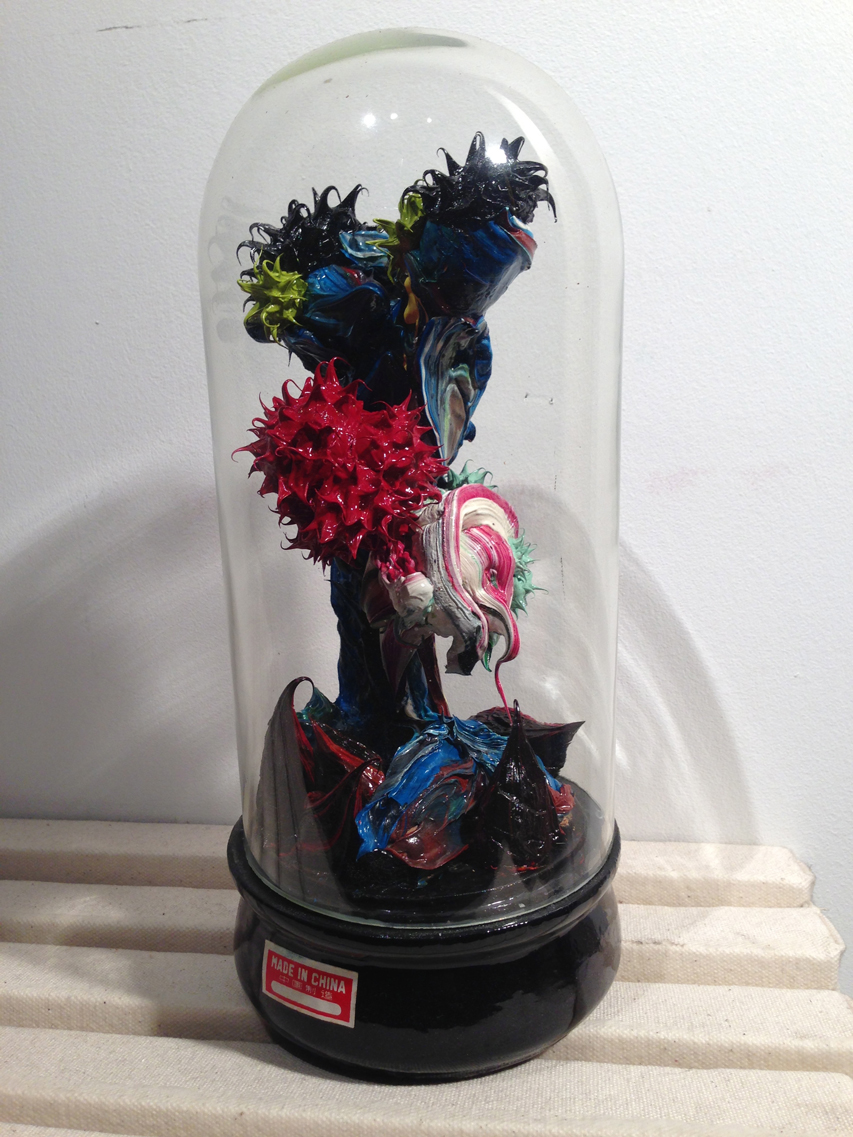
ART MARTS (SMART ART)
ART MARTS (SMART ART)for Dennis Hollingsworth
"Hi, my name is Wendy and I'm the nurse today
of Dr. McNicoll." Once, probably at the end of the
last century (nineteenth, that is), art was supposed to
last and possess 'high seriousness,' and be as
interesting as what passed for brilliant though
not especially self-conscious conversation. All
gone now, we're to believe. "I was 111th,"
says the 40 something actor, smoking and looking to
wind down after a tough session apparently just
over. Or the full moon last night huge and
raucously yellow as a house heading home,
that is, east on Sunset, where traffic now slides and
hovers toward six o'clock and non mangia.
Death, of course, is an obstacle, unlike the
easy and peculiarly beautiful light,
now just after three, heading west on Beverly,
nearing Fairfax, listening to Grieg piano which,
in admiring, the young Debussy was quick to
savor as pink bonbons with snow inside.
P.V.
This is a gift sent from an old friend and neighbor, Paul Vangelisti. Here is a little more context from his recent email to me:
Dennis,
Here at last the piece I wrote for you. Not sure what to make of it but it's part of a new (and always more curious) book I'm working on. Currently in Modena, after four chilly & drizzly days in Amsterdam. Truly fabulous and beautifully organized and presented museums. Malgosia and I miss the both of you... Paul
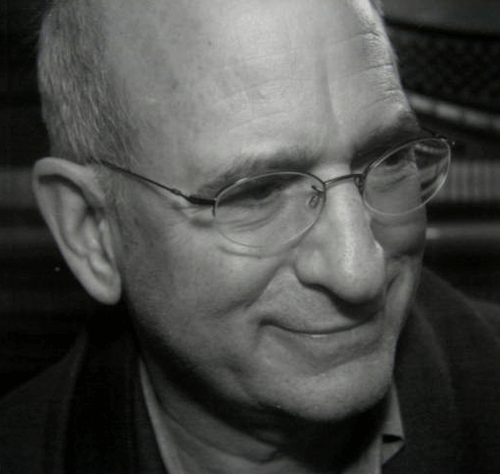
June 21, 2013
Jew York

I wasn't chosen, but I wanna be.
(The video above isn't directly related to the show, it was created in 2010.)
Links:
Untitled Gallery NYC Jew York
'Jew York' Art Exhibition At Zach Feuer Gallery Looks Divine
Zach Feuer and Untitled Announce 'Jew York' Summer Show
Papa Smurf at Hauser & Wirth

Paul McCarthy's (aka Papa Smurf) programmatic takeover of NYC continues with his Rebel Dabble Dazzle at Hauser & Wirth in Chelsea.
I saw this show when it first debuted at LA's The Box, it was and is tremendous. It was also of some minor passing interest to me that much of the pornographic aspects of this show were tucked -by and large- into the ancillary rooms of The Box; not so in Hauser & Wirth's Chelsea space. When I first walked into the Chelsea space, the first sight was of a huge projection of the central James Dean/Paul McCarthy character ejaculating on the belly and chest of a Natalie Wood look alike within the living room of the house sized set assembled within the main gallery. I pulled out my LoopCam cell phone App and debated whether to shoot that or another huge video projection of McCarthy's backside featuring his rectum, hair trimmed scrotum, chubby wrinkled penis; all within a pimply-hairy field of ass and thigh. All this, as he squeezes between his old man thighs, a huge pastry bladder of what looks like caramel pudding over the nude body of an exquisitely beautiful actress sitting (that verb is too passive, -subjected- might be a better fit) in a bathtub.
I spared you, my friends, the animated GIF but not the verbal description.
Artists who are so invested in transgression are involved in a kind of career strip tease, the boundary crossing has to be performed in finely calibrated degrees so that they don't foreclose their oeuvre in a premature ejaculation. This, McCarthy has done with panache. But still, I wonder what will follow in train? Like a drug, the thrill has to be dialed up to be able to feel it again, to make the audience feel it again.
Then again, Paul McCarthy is also on a path of emulating Walt Disney and I wonder how far he will go in this way in as much as animation and theme parks can be mounted within the art world? There is a crucial scale difference between the two realms and so for him to realize this goal, he might not be able to pack the universe of the former into the tin can of the latter. Of course, he could create his own brand of animation and film for a venue like NetFlix (notice that I didn't use the example of network TV or even HBO, since they are sun setting at different rates in our rapidly changing media landscape) or he could actually build a theme park, an Alt-Disneyland. As he continues to double down, this might be his only way out.
(Post Scripts: 1) A friend was telling me about a legal case that is being made against McCarthy by the Disney Corporation for copyright infringement. I searched the web, with no result.
2) There is a story about his Mormon heritage that should be flushed out here. I lived in Las Vegas during my high school days, and I knew many Mormons both straight laced and the renegades that we called "Jack Mormons" at the time. I wonder how much of the latter category can shine a light on McCarthy's mind and work?)
More:
"Artists are seen as one step above criminals"
http://www.huffingtonpost.com/2013/06/19/paul-mccarthy-snow-white-armory-show-disney_n_3462268.html
The Demented Imagineer
Paul And Damon McCarthy: 'Rebel Dabble Babble' Leaves Me Cold
June 20, 2013
Vitrine
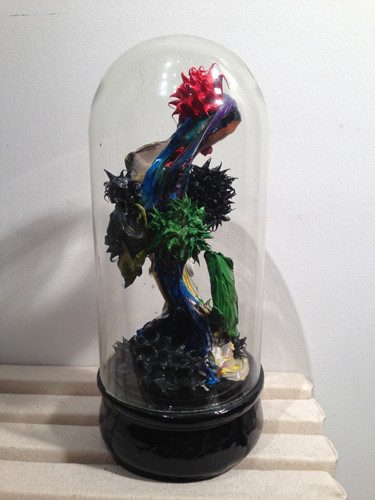
the ultimate manifestation
#415
2013
10.5"x5"diameter
Oil on Wood Armature, Glass Vitrine

Vitrine
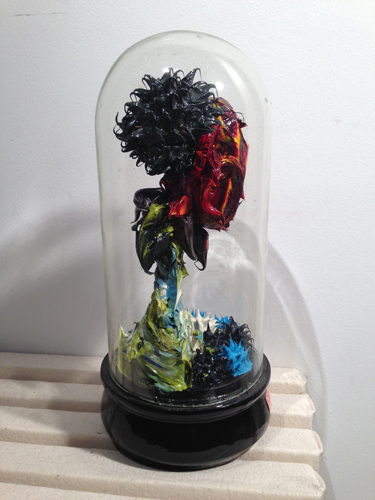
so many chimeras
#414
2013
12"x5"diameter
Oil on Wood Armature, Glass Vitrine
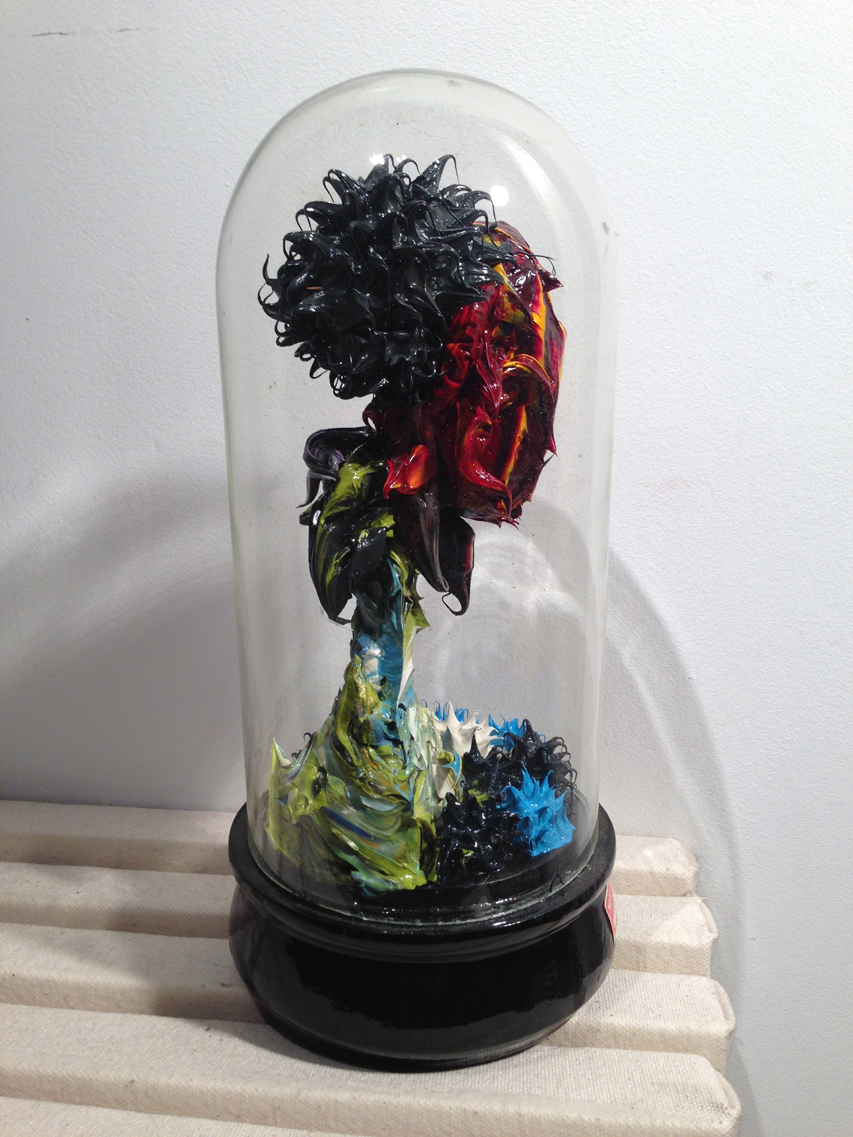
Vitrine
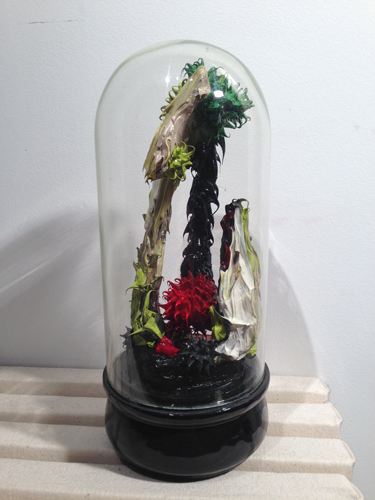
imagine the power
2013
#413
12"x5"diameter
Oil on Wood Armature, Glass Vitrine
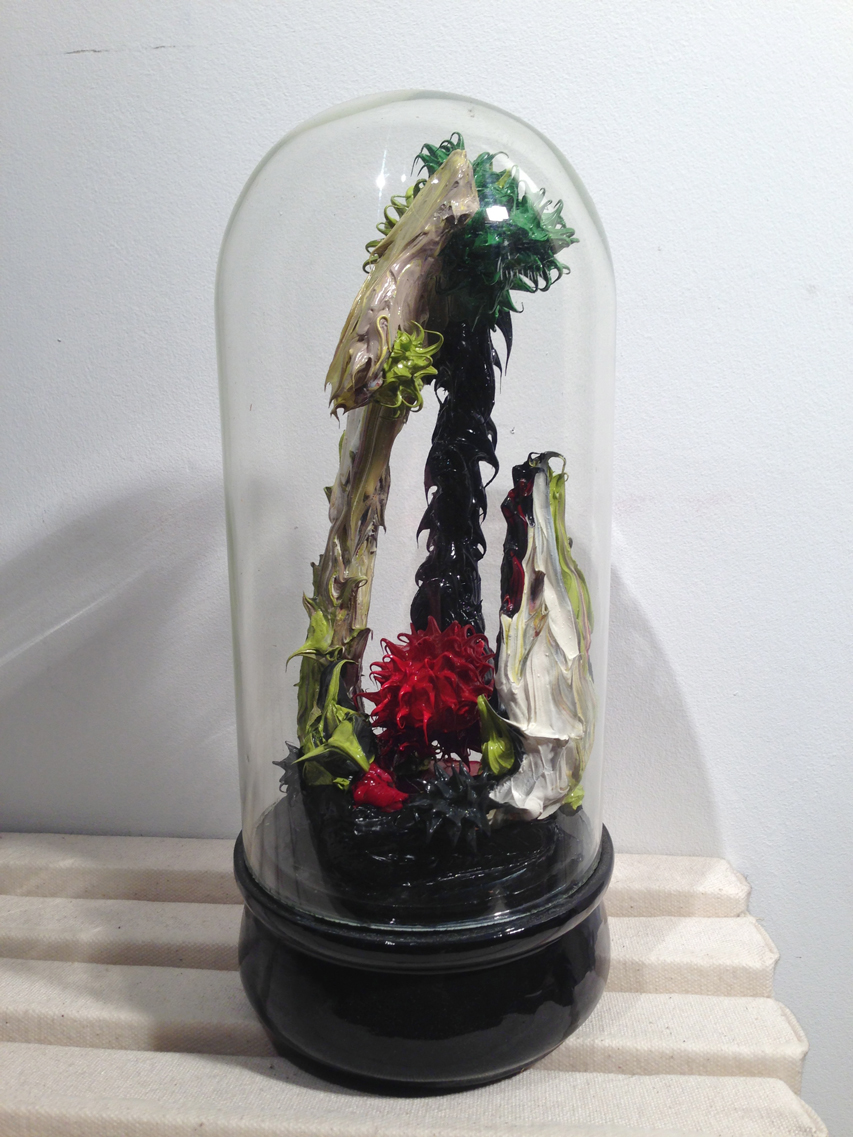
June 14, 2013
NYCHA
I'm curious about the historical transition in housing in NYC, the efforts of "slum" clearance and redevelopment:
"...of odd spots swept away by the era of LaGuardia and Robert Moses by the era of the modern superbox of public housing..."
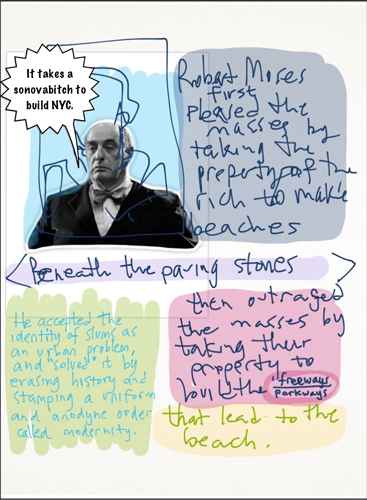
Robert Moses was only a prime exponent of a generation and it was an entire generation who was enamored of a particular idea of progress (in the first video at T=8:34, there is a photographic still of a street with a billboard advertising Chevy's, a foreshadowing of what was to come). I'm not critical of any particular idea of progress or of an enthusiastic anticipation of the future. I'm saying that the we should be suspicious of any vision whose fulfillment requires the elimination of a competing, older vision. Heritage may wither away, but it should never purposefully eliminated. I should check myself of course: 1) the vehicle for the wholesale redesign of NYC neighborhoods was "slum clearance", and whether the history recorded in the photographs featured in these videos was miserable or culturally rich or a ratio of both states... is still up in the air; and 2) the phenomena of modern superbox of housing in NYC is itself an artifact of NYC heritage. Checkity-Check: Is heritage merely anything that prevails in history???
June 13, 2013
Sky over WTC

Weather in LA is paradisal steady state. The movement of major systems operate to the north and south of SoCal as the planet moves west and the winds flow east, and therefore the skies over LA are an eddy of blue whose temperature ranges between 85˚and 65˚day by night, summer by winter, year by year. NY, not so much. The jet stream that comes in from the Pacific mixes with plumes of hot air from the gulf and so we get to witness most of the weather that affects blasts the rest of the country.
(Animated GIF courtesy of LoopCam.)
June 11, 2013
In Advance of a Studio Visit
In advance of (or better said, in anticipation of) an upcoming studio visit with Wendy White, this video by Tom Powel is excellent. She has a show opening tomorrow at Peter Makebish Gallery. See the Gallerist NY hot tip sheet that Andrew Russeth summarizes well.
Artist, Soldier
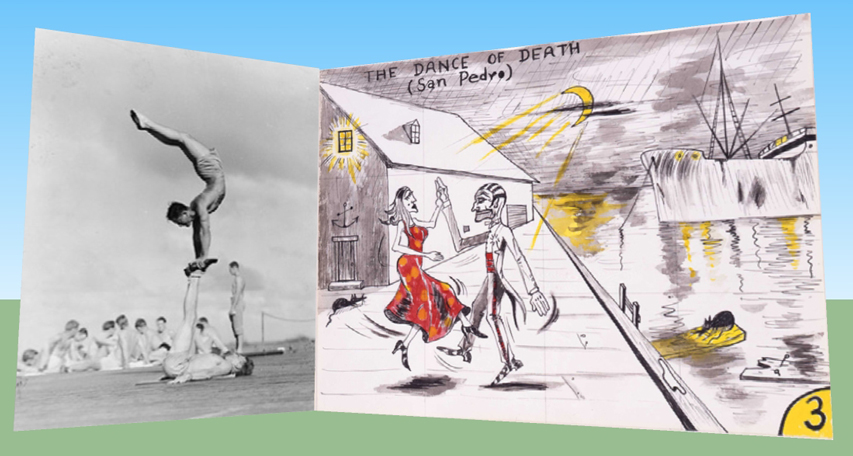
H.C. Westerman
From his obituary by Grace Glueck:
Reviewing the Whitney exhibition, John Russell wrote in The New York Times: ''There is in his work a combination of fiendish invention, boisterousness, naivete and a high-souled ethical overdrive. He never evades a question, and he doesn't mind coming on like an unreconstructed preacher.'' Fought in 2 WarsThe son of an accountant, Horace Clifford Westermann Jr. was born and raised in Los Angeles. A trim, muscular man skilled in gymnastics, he saw combat service as a Marine in World War II, and was hired by the U.S.O. for a year's tour of the Orient as an acrobat. Returning to the United States, he studied commercial art at the Art Institute of Chicago before another stint of combat duty in the Korean War.
Discovering in Korea ''an attraction for the fine arts,'' Mr. Westermann returned to the Art Institute for further study in drawing and painting. To earn money on the side, he worked as a handyman but, discouraged by what he discerned as the lack of interest in quality workmanship on the part of his clients, began to make ''little objects'' at home for his own satisfaction. In 1955, he sold his first construction to the architect Ludwig Mies van der Rohe, from an art show at the home of Ellen Borden Stevenson, former wife of Adlai E. Stevenson.
June 10, 2013
Alice Mackler at Kerry Schuss Gallery

Alice Mackler at Kerry Schuss Gallery in the LES.
This is Alice's first solo show. She got a lot of press attention from Joanne Greenbaum's curated show at James Fuentes Gallery, titled Forget about the Swetbreads earlier this year. I'd love to recount her bio here, but I don't think I could do it justice, so I recommend seeing the show and talking to gallerist Kerry Schuss, who indulged my curiosity quite generously. One upshot of her history is that she would be nominally categorized as an "outsider artist", but I don't think this distinction has the same meaning as it once did. The art world apparently seeks an authenticity of total commitment in the outsider artist, and one could speculate that this might stem from an insecurity about how a creeping professionalism could be displacing authentic commitment in the art community. Outsiders, by definition, don't seem to care about their inclusion into the art world, but the art world seems to care a great deal that they don't care, in contrast. This concern seems to arise from the grassroots of the art community, rather than from the "top down".
At the opening, Alice did seem amused about her good fortune. I'm looking forward to seeing her subsequent work to see how the limelight might -or might not- affect her imagination.
Artist, Soldier
I've been stewing on a blog post for some time in my notes. It began as an outline and over time I added to it piece by piece, therefore its staccato composition. I thought that it was about time to truck it out even though it dribbles out into an outline at its end. It was too long for one post due to the limitations of this blog engine, so I divided it up into two parts.
I'm proposing that artists and soldiers are -at the very least- just as similar to each other as they are different. Let us consider the ways...
Artist, Soldier (part1)
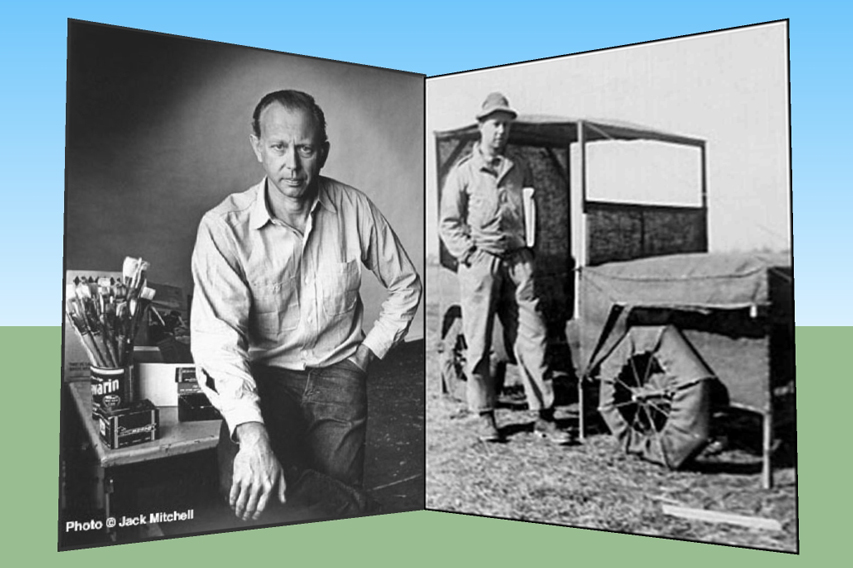
Preface: Artist, Soldier
I grew up within the military but I came of age in the art world. It all seemed perfectly natural to me until I emerged from graduate school. Most of the people that I've met in the art world seem to think that artists and soldiers are like oil and water. I'd like to shake that idea up a bit, emulsify it in a blog post.
My father was one of the first troops sent to Korea in 1950 to defend the Pusan Peninsula. He didn't talk about it when I was a kid, I remember only once where I was able to overhear a furtive account to his friends in the dregs of a party. It was only much later that I had learned more about his experience as PTSD overtook him so late in life. He reunited with a long lost brother in arms by the name of Captain Hughes, the officer in charge of his company. My father and about ten others were the sole survivors from a grinding massacre of about three hundred men. Papa re-enlisted into the Air Force afterwards and became a firefighter, runway air crash rescue. He said that he wanted to save people to recompense for the lives he took as a kid. I grew up knowing in my bones what Captain Hughes told me during my dad's waning hours fifty years after Korea, his eyes fixed on mine: "Your father... is a goddamned hero."
I was thirteen when I saw Goya's work in the flesh in the Prado and realized that art and specifically painting was my calling. This happened as my family traveled through Europe during one of our many globetrotting escapades. By that time I was already drawing, painting when I could, copying the illustrations in the margins of the art history books I was reading. Later as I graduated from high school, I joined the Navy as a rite of passage, a tribute to my father. An enlistment also gave me time to figure out my path afterwards as an artist. I was reading artist's biographies before and during my enlistment, it was commonplace and a comfort to find that more than a few artists I admired had spent time in military service. Recently, I had the good fortune of meeting one of these artists, Ellsworth Kelly, during his opening at Matthew Marks in Chelsea (no big shakes: a quick introduction by a mutual friend, a greeting and a handshake and that was it). Kelly is one of these folks: artist, soldier.
Kelly enlisted in military service during the WWII in 1943. He requested to be assigned to the 603rd Engineers Camouflage Battalion and later was transferred to what would be called the Ghost Battalion, based in Fort Meade. You can listen to Lynn Neary talk about Kelly's experiences on NPR's All Things Considered here. Greg Allen has a blog post on the topic too: Blowing Up Tanks: Ellsworth Kelly And The Camouflage Secret Army.
So, during my sailor days, I hatched my plan to substitute architecture undergrad for art undergrad, and go to art grad school afterwards. It wasn't until I got to grad school that I realized how singular my background would be. I enlisted just as the Vietnam War ended, my ship picked up refugees in the South China Sea in 1975. The rest of my service was pleasantly uneventful lots of training and ports of call. Since then, I've met only four other artists who had spent time in the military. Only one was a veteran of a war. Ellsworth Kelly's generation is fading fast. All of the artists in my cohort -from grad school to today- were not only unfamiliar with military service, but most everyone I met in the art community could not relate, a null set. I didn't solicit their opinion but when the topic of the military would arise on a rare occasion, conversations tended to curdle. Most didn't have enough of a familiarity with the subject to carry on a conversation, that's understandable. Some were mildly to strongly alienated from the soldier's life. A few --only a few-- were either disdainful or hostile, even.
It is to the latter groups of this mindset that I dedicate this blog post to. I have this notion that artists are like soldiers. I've nursed the idea for a while and now I guess it's time to take it out of incubation. But before I launch into an exposition of why I think that artists and soldiers share several important characteristics, I should clear the deck from the obvious reasons why they are different.
***
Prelude and a reality check: the counter-theme
Artists and soldiers are indeed different. They are dissimilar in ways that are profound.
Architects are like doctors, both share the spirit of the Hippocratic Oath, a responsibility to be conserving and protect their fellow citizens from harm, to be a force of growth and prosperity. Soldiers can be folded into this ethos, admittedly in counterintuitive ways. The assumption is that the protection from harm takes the form of force applied to the force that would harm one's fellow citizens.
Artists, not so much. Sure, we pursue beauty even to the farthest peculiar frontiers. Artists have flown the most hideous philosophical flags in this mission. Baudelaire's "There Flowers of Evil" is a ready example. Our aesthetic has long and justly embraced the idea that the turns of irony even unto the anti-aesthetic are integral parts of the warp of the warp and woof of the world. Danger arrests our attention. Like sex, it is a limbic first responder in our instinct for survival.
All art recuperates something from the dark side. That something is a cultural, civilizational product, the method involves aesthetics. Whether it's literature, poetry, painting, movies, even blogposts... all art deals in the part of life that indicates death. All of art trades on bad behavior (tracing forwards from Upanishad and Homer), and the chronicle of history proves this. Mike Kelly, Robert Mapplethorpe, Jason Rhodes... the list goes on, only a few of a significant population of celebrated artists from Alfred Jarry onwards, all delved deeper and ever more boldly into the dark side. Artists go there. Artists go there, the good ones at least, in order to recuperate value from loss.
An artists' action has never legitimately put the lives of its audience in actual danger, every idea is theatrical. The defense is that art exists in the realm of the imagination, which knows no bounds. The erasure and re-delineation of boundaries is the history of art world (in the West) and today, the impulse to redraw the boundary that defines art is not so strong. The ability to maintain the distinction between imagination and reality might be the best definition of sanity. Sure, the adventure of blurring the boundaries is exhilarating, but it can also be frightening as well.
Soldiers are an organized force. Artists are a disorganized force... or it might be better to say that artists are organized after the fact. Their energy is divined, patterns are searched by the intelligencia after the moment of creation as the first drafts of history are written in the museums. Soldiers train repeatedly until the routines of attack and defense are imprinted in muscle memory so that when the fog of war arrives, they can do what they have to do in the midst of chaos. The widening site of art production is pure chaos at the moment of creation. Especially now when the population of the art world is gargantuan, artists are churning a froth of creative acts which is sorted out more or less by the conventions of exhibition protocol, and historians survey, chart and rank the emerging landscape into an intelligible order.
Society organizes an armed force to protect itself and therefore soldiers begin their service with a vow to protect the constitution, the literal social contract. Artists, not so much. There is no explicit social contract for artists to serve. Artists are more like pirates in this respect. Now, even pirates have their codes of conduct, but like it is in the social world of artists, any such code is at the very least provisional and radically open to interpretation.
I'm thankful that I've only heard it said that war is boredom punctuated by horror. I can testify by experience to a correlate saying in the military: hurry up and wait. Could we say that art is the inverse of these? Is art horror punctuated by boredom? Do we not wait and then hurry up? Life in the studio is like a horror in the flux of uncertainty when we push ourselves to best others and even ourselves, not knowing how we will, if we will figure into the tale of history. And just as any artist is familiar with the frantic run up to an exhibition, there is the strange sense of having been emptied out, your guts on public display and there is no time left to improve one's aspect. Afterwards, there is something like boredom, where the last body of work has won all of the minds it could and you are left with a fresh blank page of history, your emptied studio turned out before you as you begin again to re-pump the pressure to reacquaint yourself with the demand to remake yourself anew, to be able to surprise yourself and everyone else yet again.
***
Ruskin: "No great art ever arose but in a nation of soldiers."
***
On narrative and conflict... Charlotte Higgins on Love and Greats:
"What's interesting is that The Iliad is the first book, and it's about war. Why is that? I've got a funny feeling that war and narrative are tightly bound together. Both narrative and conflict are the products of civilisations. Once you start building cities, having private property, creating hierarchies, etc, then the inescapable fact is that conflict will occur. And conflict is the stuff of drama, of stories."
***
What artists should learn from this: that art is hazardous duty.
***
Sailor or pirate?
And a symbol for "danger." (The skull-and-crossbones design would come in handy when Jobs issued one of his infamous motivational koans to the Mac team: "It's better to be a pirate than join the Navy." Painted on a flag, Kare's Jolly Roger was hoisted outside of the Mac skunkworks...)
***
"To have the arts of peace, but not the arts or war is to lack courage. To have the arts of war and not the arts of peace is to lack wisdom."
-Hayashi Razan (1583-1657)
***
Two weeks later, Jesse would be cut down by small-arms fire in Baqubah. He would survive some time before passing away. I could not possibly avenge him; I was two thousand miles away. I heard about his death in the most undignified way: a MySpace bulletin read in an Internet cafe in Rome.-Army of Dude: a blog from an Iraq War vet
Coming back to Iraq after leave, I looked at Jesse's assault pack a lot differently. I still carried it with me everywhere, but I treated it a lot better. I no longer tossed it off the Stryker into the dust. I didn't shove it into small spaces on top of the vehicle. In the outposts where we lived, I used it as a pillow.
The assault pack is not an assault pack anymore. It's a backpack. I no longer stuff it with extra grenades, ammunition magazines or packages of Kool- Aid. It now carries textbooks, calculators and pencils. I started my first classes a few months ago to fulfill the plan two years in the making. I imagined it to be a seamless transition into civilian life. Boy, I was f------ naive, even when I came home. I saw some guys falling apart from PTSD, getting drunk or doing drugs to drown it out. I thought I made it out okay, relatively.With my unassuming tan backpack at my feet, I break out in a sweat if I even think about mentioning Iraq in the classroom. I let it slide nearly every time, yielding the topic to daftly opinionated classmates. I feel like a foreign exchange student, confused about the motivation of my peers. I literally carry the burden of readjustment on my back, not wanting to let go my past but anxious to get to the future. Fractured into part war veteran and part journalism student, who I am speaking to determines which part of me is actually there in the room. To many, my past is my best kept secret. For all they know, my parents pay my tuition and do my laundry. I can be honest here. It's terrifying to be honest out there. Perhaps it's best that way.
by Alex Horton
***
Artist, Soldier (part 2)
Artist, Soldier
There were times where I've heard one or two of my artist pals refer to San Diego in disparaging terms: "That place is scary, all that military stuff there." or something to this effect. I made sure to insert the contrary: that the spectrum of people in the military are not much different from that in the rest of society, that San Diego is a fine city with a lot of things going for it, and the presence of the military there is not much different than say, the film industry is to Los Angeles or the energy business is in Houston. San Diego can acquit itself handily in terms of culture, it's that strong of a city. I don't think I reached my friend, he walked away secure in his assumption that the military=evil and art=good.
I generally agree with the sentiments of the author of these videos, Lewistonvideomaker. But which set of sentiments are we talking about? I think that there is a deep and shallow set of ideas that people can take from his message. The former is expressed well by the author in his description to the A.V.A.T.A.R. video: "
The
hilarious
visual
juxtapositions
and accompanying
soundtrack
of
baffling
one‐liners
spliced together
from
seventeen
films
are
both
a
humorous
jab
at racism in our supposedly liberal popular
culture,
as
well as
a
media
literacy
tool
for
deconstructing how whiteness and Other-ness is
portrayed
in
mainstream
films
about humanitarian crises." The latter, shallow set is that the military is simply criminal, full stop. I too found the movie 300 top be execrable. But war crimes and war atrocities do not define the military any more than racism defines the movie industry.
The Military? They're just like us. Artist, Soldier. Left, Right. We're split, culturally. Schizoid. The issue isn't whether the two are opposites, whether they are ultimately incompatible. These distinctions have ben exhausted. The issue of today, I believe, is in how they interlock. It's time to heal the split. It's time to see finer distinctions and stop the idea that we, the virtuous possesses all good that the other, whomever they might be, possess all bad.
Artists and soldiers have the same orientation. Both are faced with an existential commitment, both are putting their lives on the line. For both, future security is put at stake and the possibility of a wretched end loom in the balance. Speaking for myself and I am sure for most if not all of my fellow artists, we all have had those intitial thoughts about the hazards of a life as an artist. Our families certainly were the first to raise the alarm that it is a fool's choice to swerve away from the conventional life and the security it promises. To be an artist is to risk failure and the ultimate failure is that one's talent might not be recognized even in our now longer lived lifespans. Certainly, security is not what it used to be, and if there is a contemporary formula for success, it resembles the artistic ethos more than ever before. The aspiration of working for a company for the gold watch and retirement plan has evaporated by and large, and security has taken on qualities such as nimbleness, growing one's own talent ever more so, diversifying investments, self reliance and a continuing education that never stops. If the old script that promised security has frayed and narrowed over the years, the artist's script is as wide open as it ever was. Despite the fact that the arts have grown exponentially in recent times, it is also a fact that the art world has grown in population exponentially as well, such that one could say that the odds of success have hardly changed even so. To choose to be an artist is to choose a risk of the dimension of a lifespan. With an increasing tempo of change, there are fewer if any see havens in terms of careers. If the truth of artistic risk has softened in our long lasting and growing epoch of prosperity (recessionary setbacks not withstanding), imagine the gravity of a decision to become an artist was for our forebears. The pain of such an existential choice (more so for one's family) has lessened in our time but the pain persists and the artist who is not conscious of it is either too young to know better (ah! that immortal feeling!) or has a trust fund (nothing to be ashamed of, it's indeed a blessing no one could deny). Like the ace that is either part of a winning hand or the bottom of the deck, both artists and soldiers play the odds.
We in the art world recognize this existential decision, and here is a modicum of proof: via Two Coats of Paint (Sharon Butler), here is a snip from Adam Gopnik's story in The New Yorker about Van Gogh's Ear:
Van Gogh's ear makes its claim on our attention because it reminds us that on the outer edge there is madness to pity, meanness to deplore, and courage to admire, and we can't ever quite keep them from each other. We gawk as painters slice off their ears, but we rely on them to make up for our own timidity. We all make our wagers, but the artist does more. He bets his life.
***
"I served once beneath a great commander who asked in counsel one night of me and my comrades if we believed our calling a species of penance, a hell or purgatory through which we must pass again and again in expurgation of some crime committed eons ago? 'I do', he said. He offered his recompense for passage: 'An unmarked grave on a hill with no name for a cause we cannot understand in the service for those who hate us.' Not one of us hesitated to embrace this."-Steven Pressfield, "The Profession"
***
Creative Destruction: Scripts and Improvisation
There is warfare both within art and in the art of war.
Art is at war. Warfare is the engagement in or the activities involved in war or conflict. Art as we know it is an intergenerational struggle to reconcile the life one is living with the things one is making. And it is an internecine contest, a war in other terms, for the authority to speak for one's generation. I submit a ready example at random: in an announcement for one of Paul McCarthy's shows (NYC 2013), he describes his work as the definition of art as he sees it (I paraphrase): the overturning and disruption of society's conventions. He further defines art as distinct from entertainment in a measure of the production of ideas. Even though McCarthy is stellar, every artist has a personal philosophy but whatever that philosophy is, it will be a claim on a voice of historical importance.
It is attributed to Napoleon, seemingly a variation on Aeschylus, that the battle plan is the first casualty in battle. All martial arts are a contest of pattern creation and pattern disruption. Both the artist and the soldier act first within and then outside the box, of the protocols of habit and fashion, of established systems. The first hint of an idea, of a pass at a blank canvas, on that lump or pile of sculptural material, that first take on a film set... is like the leap from cover, the heave out from the foxhole. Preconceptions of what should happen give way to brute material facts and processes of the medium. Moment to moment, attack and re-attack deliver completely new circumstances that must be acknowledged and compensated for. Every creative act produces new information that modifies all subsequent acts. New plans are devised then improvised and each in succession are modified in flight, in a fight. Soldiers use deception to attack into the preconceptions of an adversary. Artists seek out conventions to overturn and and reorder the preconceptions of the audience.
Both the artist and the soldier bear the responsibility of presiding over destructive forces. This is obvious of course in the military, where soldiers talk of delivering steel on target, of being managers of violence. We artists ourselves too have a full array of tools whose effect is one of disruption for creative purpose. We too manage destructive forces. We draw and redraw the boundary between fantasy and reality, risking the madness that stems from losing such a distinction. We employ the energy of revolution in themes big and small, heedless of potential negative or even catastrophic consequences. Terms and ideas such as interrogation, resistance, deconstruction, disruption, interruption, argumentation, are nouns in a martial language both inside the academic arts and inside the Pentagon.
Paradigm and counter paradigm is the kernel in the story of art history that prevails in our darkened art survey classrooms. Disruption and fragmentation are normal methodologies in our practice. We as culture's outliers exist in order to break open the scabs of convention and the closure of experience and reflection. The avant-garde is reported to be passé today, but who could doubt that such an entity does not haunt us as each new season trumpets all that is supposedly new and of-our-time? We artists, like the soldier, the fireman and the policeman, all go to where the danger is. What is art history other than a chronicle of hubris, violence, of power in movement, of deception and subterfuge, of the acts of the bad son or daughter? What movie or novel does not have as a premise, some form of bad behavior?
***
Combat and Logistics
A soldier in combat is only half of the story. The other half is supplying the front lines with food, water, equipment, ammunition and information. Like soldiers, there are two kinds of people in the art world. Artists, like soldiers are fed into the maw and then there are the people who together form the infrastructure that sets the stage of art history (collectors, gallerists, curators, critics). Support personnel set the stage for battle and there would be no success in war without it. For example, In WWII,Eisenhower bypassed Paris so that the logistical needs of a recaptured capitol would not detract from the war machine driving towards a decapitation in Berlin.
We are all familiar with the type in pop culture: the cigar chomping supply sergeant who knows how to obtain that impossible and critical item, who has the access to whisky and porn (insert your favorite contraband). Witness Don Rickles' Sergeant Crapgame, or Phi Silver's Sergeant Bilko, for example. These are the pop culture stereotypes. Here's a link to a real supply sergeant, to sober up the mediated image.
In our art world, there are many types of support personnel: gallerists, writers (critics), curators, arts administrators of many types. Many of these art world support people are grounded in a clear recognition of the indispensable nature of their role in the larger system, and there are an albeit contestable percentage of them who are indeed venal. Let's be real here: there is no regulation in the art world, it is a Wild West where there is no law against insider trading. In both varieties military and art, there are those who game the system for either personal gain or to overcome the inherent lethargy intrinsic to all systems in order to deliver such much needed support, to overcome the system for its own good. One character is committed to the mission, the other exploits the system for personal gain. The spectrum of human character is fully represented in both worlds.
"an entrepreneurial soldier, Milo Minderbinder, "exposed" as a ruthless, moneymaking crook in an early vision of the novel, developed into a more nuanced figure, amoral rather than simply villainous."-Vanity Fair, The War for Catch-22
by Tracey Daugherty
***
Solitude and Leadership
If you want others to follow, learn to be alone with your thoughts
By William Deresiewicz
That is exactly what places like Yale mean when they talk about training leaders. Educating people who make a big name for themselves in the world, people with impressive titles, people the university can brag about. People who make it to the top. People who can climb the greasy pole of whatever hierarchy they decide to attach themselves to.Now everyone knows that the novel is about imperialism and colonialism and race relations and the darkness that lies in the human heart, but it became clear to me at a certain point, as I taught the novel, that it is also about bureaucracy--what I called, a minute ago, hierarchy. The Company, after all, is just that: a company, with rules and procedures and ranks and people in power and people scrambling for power, just like any other bureaucracy. Just like a big law firm or a governmental department or, for that matter, a university. Just like--and here's why I'm telling you all this--just like the bureaucracy you are about to join. The word bureaucracy tends to have negative connotations, but I say this in no way as a criticism, merely a description, that the U.S. Army is a bureaucracy and one of the largest and most famously bureaucratic bureaucracies in the world. After all, it was the Army that gave us, among other things, the indispensable bureaucratic acronym "snafu": "situation normal: all fucked up"--or "all fouled up" in the cleaned-up version. That comes from the U.S. Army in World War II.
But I think there's something desperately wrong, and even dangerous, about that idea. To explain why, I want to spend a few minutes talking about a novel that many of you may have read, Heart of Darkness. If you haven't read it, you've probably seen Apocalypse Now, which is based on it. Marlow in the novel becomes Captain Willard, played by Martin Sheen. Kurtz in the novel becomes Colonel Kurtz, played by Marlon Brando. But the novel isn't about Vietnam; it's about colonialism in the Belgian Congo three generations before Vietnam. Marlow, not a military officer but a merchant marine, a civilian ship's captain, is sent by the company that's running the country under charter from the Belgian crown to sail deep upriver, up the Congo River, to retrieve a manager who's ensconced himself in the jungle and gone rogue, just like Colonel Kurtz does in the movie.
You need to know that when you get your commission, you'll be joining a bureaucracy, and however long you stay in the Army, you'll be operating within a bureaucracy. As different as the armed forces are in so many ways from every other institution in society, in that respect they are the same. And so you need to know how bureaucracies operate, what kind of behavior--what kind of character--they reward, and what kind they punish.
****
Elias and Barnes
There are two types of soldiers on the battlefront. I'm thinking of the two sergeants brought to cinematic life in the 1986 movie Oliver Stone, Willem Dafoe's Sergeant Elias and Tom Berenger's Sergeant Barnes. This, from an essay in part about Platoon by Dan B. Butler :
Sergeant Elias, the "good" sergeant, is given an almost ethereal quality, whereas Sergeant Barnes is much more self-serving. Although Barnes and Elias take on almost mythic qualities inPlatoon, their characters are based in reality, an important element in the film. Oliver Stone described the two men in 1987:Let us consider the fighting styles of Barnes and Elias.I knew the two sergeants in the different units. Sergeant Barnes was wounded in the face. He was a good soldier who had his men's trust. But he had one huge failing: his murderous obsession with the Vietnamese. He hated them all, men, women, and children. Sergeant Elias was almost exactly the opposite: he was an anti-racist who looked like the rock star, Jim Morrison-a handsome man, well-dressed, loved by his troops.
Elias abandoned himself to the chaos of combat. He worked better alone, stripping off non essential gear to prowl and rush the jungle of the battlefield. Hip, pot smoking, naturally counter culture, spiritual, the character of Elias was imbued with an aura that is universally appealing. Hector. Christ. Love.
Barnes was identified as like Melville's Ahab:
The White Whale swam before him as the monomaniac incarnation of all those malicious agencies which some deep men feel eating in them, till they are left living on with half a heart and half a lung. That intangible malignity which has been from the beginning; to whose dominion even the modern Christians ascribe one-half of the worlds; which the ancient Ophites of the east reverenced in their statue devil; -- Ahab did not fall down and worship it like them; but deliriously transferring its idea to the abhorred white whale, he pitted himself, all mutilated, against it. All that most maddens and torments; all that stirs up the lees of things; all truth with malice in it; all that cracks the sinews and cakes the brain; all the subtle demonisms of life and thought; all evil, to crazy Ahab, were visibly personified, and made practically assailable in Moby-Dick. He piled upon the whale's white hump the sum of all the general rage and hate felt by his whole race from Adam down; and then, as if his chest had been a mortar, he burst his hot heart's shell upon it.Barne's martial art was rage all the more frightening for his methodological intensity. The corrosive rage of Achilles. Hate.
...and so too artists? Consider perhaps the rage of early Chris Burden, of our scowling Serra, the protesting Spero,
Consider the love (or somesuch) that glows from the work of Bonnard, Koons,
how they are different:
how they are complimentary:
one secures freedom
the other employs it
The soldier is reconciled with oblivion even before they make their vow to defend the constitution. The artist has to learn how to accept oblivion in varying magnitudes.
each defends the interests of the other
June 7, 2013
June 5, 2013
Javier's Report From Istanbul
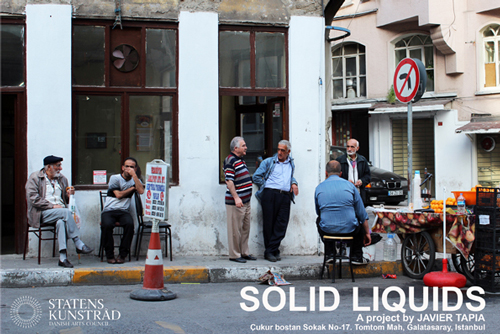
Javier Tapia (I've blogged about my visit with him in Copenhagen here in 2010) has a residency and a show in Istanbul this spring, here is a short description:
The project Solid Liquids aims to generate a social sculpture in the center of Istanbul, mixing elements of the local life, an artist work and institutional structures.
The initial part of this project is based on research, using the time of an artist residency in the hosting town, in this case, Istanbul. This investigation navigated through the history of Istanbul and it's memory, the use of public space, commercial and cultural. Such work provided a collection of documents and objects from local libraries, book shops, antique stores, the center of research SALT, interviews and field trips, all together, with photo documentation, provided the ground for the final outlook of the installation and its features. A sculptural platform made to be used and shared by all who wants to join.
Today, he sent me another email in the wake of the recent mass protests in Istanbul's historic Taksim Square. Here is his report:
Istanbul, Wednesday June 5th, 2013.
I arrived to Istanbul in early April of 2013. I came to Turkey to work on a residency with SALT and the Danish Arts Council. The purpose of my trip, besides doing the usual duties of an art residency, was focused on developing a project called Solid Liquids; A social sculpture, in the center of the city, dealing with issues of history, memory, high and low culture, macro and micro politics and architecture.As time passed by, my involvement with the local history and Istanbul's inhabitants became closer and closer, however, always from the foreigner perspective. My friend, and this time around assistant as well, Can Subiler, has introduced me to big part of what Istanbul was and is today. Taking me inside his circle of friends and showing me some aspects of the city I would never be close if it wasn't for them.
When the time to open my show came around, last week, I could feel and see how the little environmental movement, near the Gezi Park, next to Taksim square, in the center of the city, was growing.
The original movement was focused on getting signatures from the people visiting Taksim, in order to make a petition to be hand to the mayor of Istanbul to save Gezi Park of being destroyed for the construction of a proyected shopping mall. The movement and the demonstrations were pacific, however, last week the police moved in, as it has been communicated in the international press, using incredible amounts of tear gas in order to chase away the demonstrators. The battle started.
The different factors influencing the recent fights point out to one thing; the common discomfort, from diverse number of factions of Turkish society, towards the Prime Minister Recep Tayyip Erdogan. The fight for a small park is symbolic. Now the fight is all over Turkey. The people is disappointed about how the Prime Minister is ruling the country, promoting divisions and making laws and rules that seems to undermine the spirit of what identify Turkey. Obviously; this is an historical familiar scenario of power.
In early April, my impressions of the Turkish society were mixed, since once I came out of the role of a tourist, taking pictures and eating good food, I could see that the dialogue between people was friendly, however distant. Students and professionals went on their own business, as well as everybody else, filling their roles, without integrating themselves in "the others" activities. My impression of their social development status was even more confirmed while I was doing my research, talking to Turkish old and young, walking on their streets, looking how they reacted to each other. Somehow not a negative view, nevertheless a distant one.Friday 31st of May was the day the fight started.
If the Prime Minister Tayyip would have heard or create an atmosphere of dialogue, nothing of the reported violence would had happen. Nevertheless, he still wants to continue with the projects, as a symbol of his arrogance in power. His attitude has provoked that people that once were indifferent to each other has come together to demonstrate. The fact that the police attacked a peace demonstration, lead by an environmental group, has generated a sense of urgency that putted aside all the things that were pulling people apart before.
As Can, my friend told me, "I did not think this could be possible, I feel I want to cry out of emotion"... I have seen young and old, simple workers and professionals, famous and anonymous, hippies and punks, religious and secular, homosexuals and heterosexuals, football fans and academics, all come together, with such a big overall support that this movement cannot longer be ignored. They have fought for freedom of speech, for the right to be united against a government that wants to impose rules that aimíng divisions, focusing in economical gain and power.
That Friday 31st of May, gas literally came in to my apartment, I could not longer be there and wait for everything to calm down. I took up on myself to register as much as I can, with photos and videos, listening to people and joining them in their demonstrations, to communicate to everybody I can what I am experiencing.
Demonstrators are unarmed, and if anybody comes close to the conflicted areas, everybody is welcomed. People have clean the mess and garbage after the fights, they have organized themselves, collectively (and I mean thousands of people) to share food and water and anything needed to keep their stand. The demonstrators have not used guns or bombs, and even between them there is a spirit of collaboration and understanding of why is the fight up. In the night, as how it has been, when the police moves in, they defend themselves and the Gezi Park with stones and barricades. The rest of the city supports them, clashing pots and making noise, marking a global state of support. Every day, the last few days, when people see others marching towards Taksim, in every neighborhood, they received a warm ovation. Everybody is helping each other. Storekeepers, hotels, and even some policemen, have turned to give support.
It's beautiful to see people joining together in this fight. In the world we live today what is happening in Istanbul and in other cities of Turkey is not a fight for a small park. The fight is also an inspirational example of bravery and selflessness. The legacy of these days, and the people joining the demonstrations is of courage in the face of despair, conviction in the time of indifference and persistence in the face of overwhelming adversity. We all owe to them our gratitude.
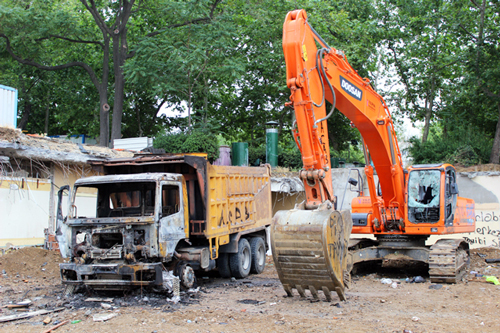
More context:
Protests Change Turkey's Political Landscape: A Report From Istanbul by Austin Bay.
Erdoğan Over the Edge by Claire Berlinski
Ana and Iñaki

A snapshot of a visit to MOMA to see Claes Oldenburg: The Street and the Store. Friends Ana and Iñaki stopped to say hello while on their way to Spain.
The show sharpened my pocket theory of how the high modernism of the New York school of painting flipped into the postmodern era. If Rothko, de Kooning, Pollock, etc were trying to touch G-d via material means, young Warhol, Oldenburg, Hamilton, etc pointed toward life via conceptual means. So from the end of the 50's onward streamed Pop, Minimalism, Conceptualism, Critical Theory, and a spreading delta (as in a river delta that was once a cold mountain stream) of assorted categories of the way artists could index the world around them.
A snip from Blake Gopnik's Dark Roots of a Pop Master's Sunshine:
Ann Temkin, the museum's chief curator of painting and sculpture and the coordinator of the Oldenburg exhibition -- a more focused version of a show first seen at Vienna's museum of modern art -- referred to "The Street" (1960), Mr. Oldenburg's first mature work, as "an absolute masterpiece." It was an art installation before the term was current, shown for six weeks in a shabby basement gallery run by the Judson Memorial Church on Washington Square. Walls were covered with crude, barely legible cutouts of people, cars, bikes and guns -- basic ingredients of life on the Lower East Side -- made from found cardboard and slathered in black paint. The floor was awash in detritus picked off the pavements around Mr. Oldenburg's home, and the whole mess also functioned as a backdrop for some of the earliest happenings. For the one called "Snapshots From the City," Mr. Oldenburg dressed in rags and writhed and jerked amid the trash, finally pulling out a cardboard gun and miming suicide. "We were received in not too friendly a way," he recalled. "We were changing the rules." Ms. Temkin said she detects an echo of Mr. Oldenburg's early work in the rise of garbage art and abject assemblage today, as well as in performance. "I see a whole host of performances by artists in their 20s, and I'm convinced that they don't know about these precedents," she said. "They shouldn't think they're inventing the wheel."
The brilliance of the postmodern turn was the realization that the status quo of high modernism was spent (no one could touch G-d better than Rothko and Pollock) and that its' ordinates could be converted into their antipodes. To repeat: where once artists tried to touch G-d through material means, the new generation pointed to everyday life through conceptual means.
Today, I feel, and others feel the exhaustion of the ambient narrative (to repeat Temkin: "They shouldn't think they're inventing the wheel"). Today's art world is a herd of mavericks. Revolution has a short shelf life. How do you revolt on revolution without becoming reactionary? (I'm thinking of my friends who came of age during the Punk Movement and their skeptical reaction to the Met's PUNK: Chaos to Couture) Culture naturally coagulates and art naturally breaks the scabs open, that's what it does.
The ordinates that we have inherited today aren't so easily flipped as they apparently were before. Antithetical options have been spent, at least temporarily. My guess is that it will require a synthesis of the two, both modern and the postmodern. We must repair the schizoid break. The problem is that this formulation doesn't yield the profusion of form and ideas that the gestalt of a zeitgeist should.
(Animated GIF via LoopCam)
